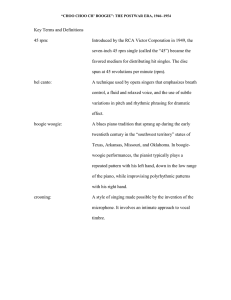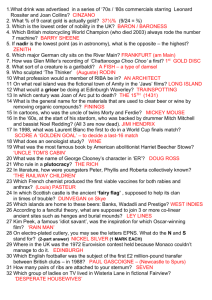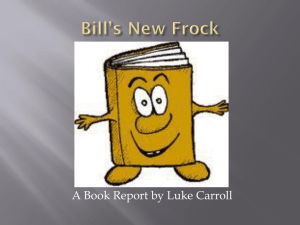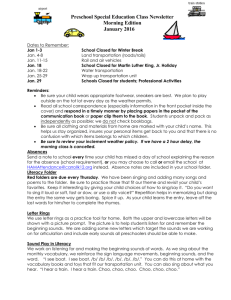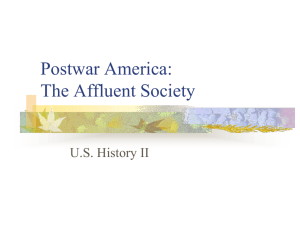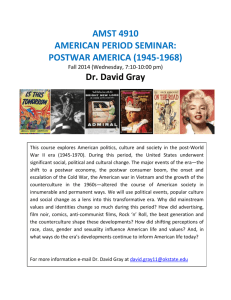Chapter Outline I. Introduction
advertisement
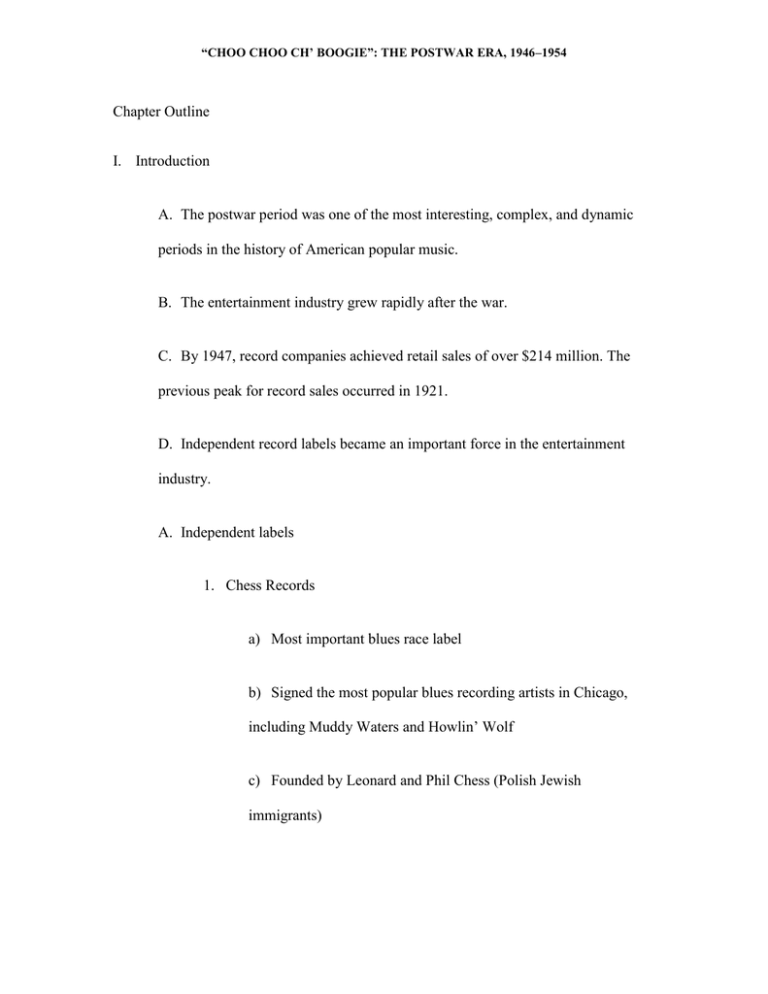
“CHOO CHOO CH’ BOOGIE”: THE POSTWAR ERA, 1946–1954 Chapter Outline I. Introduction A. The postwar period was one of the most interesting, complex, and dynamic periods in the history of American popular music. B. The entertainment industry grew rapidly after the war. C. By 1947, record companies achieved retail sales of over $214 million. The previous peak for record sales occurred in 1921. D. Independent record labels became an important force in the entertainment industry. A. Independent labels 1. Chess Records a) Most important blues race label b) Signed the most popular blues recording artists in Chicago, including Muddy Waters and Howlin’ Wolf c) Founded by Leonard and Phil Chess (Polish Jewish immigrants) “CHOO CHOO CH’ BOOGIE”: THE POSTWAR ERA, 1946–1954 2. Atlantic Records was founded in 1947 by Ahmet Ertegun, son of the former Turkish Ambassador to the United States, and Herb Abramson, former A&R man for National Records. a) Based in New York City b) Artist roster included Ruth Brown, Big Joe Turner, Ray Charles, Ben E. King, and Otis Redding. E. Record companies began to target young people. 1. People under 21 made up one-third of the total record-buying population of the United States. 2. Many hit records of the 1940s and 1950s were romantic songs performed by crooners with an orchestral backup. 3. Larger record companies (Columbia, Decca, and RCA) were focusing their attention on mainstream pop. F. Popular music and technology in the postwar era 1. Magnetic tape—better sound quality than previous methods of recording; recordings could be edited and overdubbed. “CHOO CHOO CH’ BOOGIE”: THE POSTWAR ERA, 1946–1954 a) Greatest innovator in this field was Les Paul (1915–2009). (1) His early experiments with overdubbing were on wax discs rather than magnetic tape. 2. “Battle of the Speeds” a) In 1948, Columbia Records introduced twelve-inch, 33 1/3 rpm, long-playing discs (LPs). b) In 1949, RCA Victor introduced seven-inch, 45 rpm discs—the format for hit singles. 3. Radio a) Increased influence of disc jockeys (DJs) on popular music b) The first commercial FM broadcast took place in 1939. G. Rise of the big singers 1. By 1946, the focus of popular attention had shifted away from celebrity instrumentalists and bandleaders toward a new generation of vocalists. a) Many of the top vocalists started their careers during the swing era. “CHOO CHOO CH’ BOOGIE”: THE POSTWAR ERA, 1946–1954 b) The musicians’ union recording ban of 1942–44 did not apply to vocalists. c) Many of the vocalists sang under their own names, often with choral accompaniment. 2. Frank Sinatra (1915–98) a) Born in Hoboken, New Jersey, into a working-class Italian family b) Between 1937 and 1939, worked as a singing waiter for the Rustic Cabin, a nightclub in New Jersey c) Later worked for Harry James and Tommy Dorsey d) Sinatra was heavily promoted on radio, at the movies, and in the press, and his popularity soared. e) Singing style (1) Combined the crooning style of Bing Crosby with the bel canto technique of Italian opera (2) Influenced by female jazz and cabaret singers such as Billie Holiday and Mabel Mercer 3. Listening: “Nancy (With the Laughing Face)” “CHOO CHOO CH’ BOOGIE”: THE POSTWAR ERA, 1946–1954 a) Peaked at Number Ten on the Billboard charts b) String instruments dominate the instrumental accompaniment. c) Conventional thirty-two-bar AABA form d) Cowritten by the Tin Pan Alley veteran Jimmy Van Heusen and the television and film comedian Phil Silvers in honor of the birth of Sinatra’s daughter Nancy e) The brief orchestral introduction begins with four bars of waltz rhythm (three beats per bar), then shifts into the four-beat meter of the song. f) Sinatra’s voice is relaxed and unforced, with warmth and a slight vibrato. 4. Nat “King” Cole (1917–65) a) The most successful black recording artist of the postwar period b) In both musical and commercial terms, the greatest postwar crooner c) Born Nathaniel Coles in Montgomery, Alabama “CHOO CHOO CH’ BOOGIE”: THE POSTWAR ERA, 1946–1954 d) His family moved to the South Side of Chicago when he was four years old. e) His father was the pastor of a Baptist church; Nat was playing organ and singing in the choir by age twelve. f) He made his first recording in 1936, in the Solid Swingers, a jazz band led by his brother Eddie Cole. g) Nat Cole, a brilliant piano improviser, exerted a strong influence on later jazz pianists such as Oscar Peterson and Bill Evans. h) He moved from Chicago to Los Angeles in 1937 and formed his own group, the King Cole Trio. i) Along with the Mills Brothers and Louis Jordan, Cole was one of the first African American musicians to cross over regularly to the predominantly white pop charts. j) Although he continued to record a range of material— including jazz performances with the King Cole Trio—Cole’s biggest commercial successes were sentimental ballads, accompanied by elaborate orchestral arrangements: (1) “(I Love You) For Sentimental Reasons” (1946) “CHOO CHOO CH’ BOOGIE”: THE POSTWAR ERA, 1946–1954 (2) “Nature Boy” (1948) (3) “Unforgettable” (1950) (4) “Mona Lisa” (1950), his biggest hit; sold over five million copies (5) “Too Young” (1951) 5. Listening: “Nature Boy” a) Written by Eden Ahbez (1908–95) b) Performed by Nat “King” Cole accompanied by Frank DeVol’s Orchestra c) Recorded in 1948; held the Number One position on the Billboard pop charts for eight weeks d) “Nature Boy” was the first record to present Nat “King” Cole’s voice with full orchestral accompaniment. e) The song is in a minor key, which is infrequent in mainstream popular music but common in Jewish music and is associated in the popular imagination with sadness, longing, and exotic images of the Orient. “CHOO CHOO CH’ BOOGIE”: THE POSTWAR ERA, 1946–1954 f) It is the orchestral arrangement along with Cole’s honeyed baritone voice that makes this record work. II. Urban Folk Music: The Weavers A. Urban folk 1. Appeared on the pop charts in the early 1950s 2. Combined a number of seemingly contradictory tendencies a) Inspired by rural folk music yet performed by urban intellectuals b) Drew inspiration from the populist protest songs of Woody Guthrie yet was used by the record industry to generate millions of dollars in profits 3. The Weavers were the first urban folk group to achieve commercial success. a) A quartet led by the singer, banjo player, and political activist Pete Seeger (b. 1919) b) Formed in 1948, they grew out of an earlier group called the Almanac Singers, which had included Seeger and Guthrie. “CHOO CHOO CH’ BOOGIE”: THE POSTWAR ERA, 1946–1954 c) With a repertoire based on American and international folk songs, the Weavers performed at union rallies, college concerts, and urban coffeehouses. d) The group was “discovered” at a New York City nightclub by Gordon Jenkins, managing director of Decca Records. e) Between 1950 and 1954, they placed eleven records in the Top 40. f) Three members of the group, including Seeger, were accused of being Communists during the early 1950s. (Their main accuser later admitted that he had fabricated the charges and went to prison for perjury.) g) Decca Records, unwilling to withstand the heat, dropped their contract, and the Weavers never again appeared on the pop music charts. 4. The Weavers’ singalong version of “Goodnight Irene,” composed by the Louisiana-born musician Huddie Ledbetter (aka Leadbelly, 1889– 1949), was the most successful of their recordings, reaching the Number One position on the pop charts in 1950. “CHOO CHOO CH’ BOOGIE”: THE POSTWAR ERA, 1946–1954 a) The strophic form of the song is clearly related to the folk ballad tradition, with a series of verses and a recurring chorus (Irene goodnight, Irene goodnight. . .). b) On “Goodnight Irene,” as on their other hit records of the early 1950s (“Tzena, Tzena, Tzena,” “So Long (It’s Been Good to Know Ya),” “On Top of Old Smoky,” and “Wimoweh”), the Weavers were accompanied by the orchestral arrangements of Gordon Jenkins, who also worked with Frank Sinatra, Nat “King” Cole, and other pop stars. 5. Despite the folksy informality of much of their later work, the Weavers’ “Goodnight Irene” and other hits on the Decca label are pop records. 6. They helped define a niche in the popular market for folk-based popular music, including the later work of the Kingston Trio; Peter, Paul, and Mary; and Bob Dylan. 7. The Weavers’ use of international materials, including Israeli, Cuban, and South African songs, make them the first world beat artists. “CHOO CHOO CH’ BOOGIE”: THE POSTWAR ERA, 1946–1954 III. The Mambo Craze (1949–1955) A. The mambo was the most popular form of Latin dance music in the United States in the years just before the rise of rock ’n’ roll. 1. Associated in the popular imagination with romance, excitement, and excess 2. In fact a tightly regimented musical form B. The musician who did the most to popularize the mambo, throughout Latin America and the United States, was Damaso Perez Prado (1916–1989). C. “Mambo No. 5,” written by Perez Prado, performed by Perez Prado and His Orchestra (1949) 1. Modular form, constructed out of a small number of melodic-rhythmic building blocks 2. Prado himself contributed not only on piano but also by dancing, leaping, and shouting onstage D. The mambo craze started by Perez Prado gave rise to hundreds of imitations. 1. In many ways, the most interesting of the mambo-inspired pop hits was “Mambo Italiano,” performed in 1954 by Rosemary Clooney. a) Anthem to hipness that plays on common ethnic stereotypes “CHOO CHOO CH’ BOOGIE”: THE POSTWAR ERA, 1946–1954 IV. Southern Music in the Postwar Era A. After World War II, the market for forms of popular music rooted in the traditions of the American South reemerged with new vigor. B. The old categories “race music” and “hillbilly music” underwent a series of name changes, reflecting shifts in social attitudes and in the music industry’s perception of the economic potential of southern music. C. In 1942, Billboard began to list these records, subsuming them under the single category “western and race,” a hybrid designation that was soon changed to “American folk records.” D. In 1949, Billboard began using the terms “rhythm & blues” and “country and western” for “race” and “hillbilly,” respectively. E. During the late 1930s and the 1940s, millions of people migrated from the rural South in search of employment in defense-related industries. 1. Cities such as Chicago, Detroit, Pittsburgh, New York, Washington, D.C., Nashville, Atlanta, and Los Angeles were home to large populations of transplanted southerners whose musical tastes were shaped by their experience of rural traditions but also by the desire to forge new, urbanized identities. “CHOO CHOO CH’ BOOGIE”: THE POSTWAR ERA, 1946–1954 2. This domestic immigrant population greatly expanded the target audience for southern-derived music, providing a steady source of support for the venues where country and western and R&B groups played. 3. Radio played a crucial role in the popularization of this music. a) There was an increase in the number of radio stations catering to transplanted southerners, some capable of saturating the entire country’s airwaves, others low-wattage affairs with a broadcasting radius of only a few miles. b) The country music radio business was booming in the late 1940s and early 1950s, with new shows modeled on Nashville’s Grand Ole Opry coming on the air in all of America’s major cities and on hundreds of small stations that sprouted in rural areas. c) During the war, a number of white DJs began to mix in black popular music with pop records. d) 1949 marked the inauguration of the first radio station dedicated to playing music for a black audience—WDIA in Memphis, Tennessee, featuring the blues musician and disc jockey B. B. King. F. The AFM recording ban of 1942–44 and the rise of BMI provided many southern-born musicians with new opportunities for recording. “CHOO CHOO CH’ BOOGIE”: THE POSTWAR ERA, 1946–1954 1. Because many of these performers did not belong to the musicians’ union, the ban on studio recording did not apply to them, and they were free to continue making records. 2. Similarly, the success of BMI in licensing southern-born songwriters was based on ASCAP’s long-standing refusal to admit these musicians as members. 3. In the end, the combined prejudice of these mainstream music institutions against rural, southern, and black musicians backfired. 4. The success of country and western and R&B music was indebted to the reemergence of dozens of small, independent record labels. V. Rhythm & Blues A. Described music performed almost exclusively by black artists for sale to African American audiences 1. Loose cluster of styles rooted in southern folk traditions 2. Shaped by the experience of returning military personnel and hundreds of thousands of black Americans who had migrated to urban centers such as New York, Chicago, Detroit, and Los Angeles during and just after the war 3. The top R&B recordings of the late 1940s and early 1950s included “CHOO CHOO CH’ BOOGIE”: THE POSTWAR ERA, 1946–1954 a) swing-influenced “jump bands,” b) Tin Pan Alley–style love songs performed by crooners, c) various styles of urban blues, and d) gospel-influenced vocal harmony groups. B. Small, independent record labels emerged during and just after the war. VI. Jump Blues A. The first commercially successful category of R&B, flourished during and just after World War II 1. During the war, the leaders of some big bands were forced to downsize. 2. They formed smaller combos, generally made up of a rhythm section (bass, piano, drums, and sometimes guitar) and one or more horn players. 3. These jump bands specialized in hard-swinging, boogie-woogie–based party music, spiced with humorous lyrics and wild stage performances. B. Louis Jordan (1908–75) 1. Led the most famous jump band, The Tympany Five “CHOO CHOO CH’ BOOGIE”: THE POSTWAR ERA, 1946–1954 2. Arkansas-born saxophone player and singer who began making recordings for Decca Records in 1939 3. The first jump band musician to appeal to a mass audience 4. Flamboyant style and humorous lyrics 5. Ensemble setup—two trumpets, two saxophones, bass, piano, and drums—became the standard for R&B music C. Listening: “Choo Choo Ch’ Boogie” (1946) 1. Louis Jordan’s biggest hit a) Released in 1946 by Decca Records b) Topped the R&B charts for an amazing eighteen weeks, reached Number Seven on Billboard’s pop hit list, and sold over two million copies. c) Exemplifies key elements of the jump blues style of R&B d) Cowritten by Milt Gabler, Jordan’s producer, and two country and western musicians who worked at a radio station in New York City 2. The title of the song draws a parallel between the motion of a train and the rocking rhythm of boogie-woogie music. Boogie woogie provided an “CHOO CHOO CH’ BOOGIE”: THE POSTWAR ERA, 1946–1954 important link between R&B and country music during the postwar period. 3. Form a) Series of twelve-bar blues verses, alternated with an eight-bar chorus b) Combines elements of African American music and Tin Pan Alley song 4. The arrangement—devised by Gabler and Jordan a) Opens with a twelve-bar instrumental introduction in which the horns (a trumpet and two saxophones) imitate the sound of a train whistle b) The rhythm section establishes a medium-tempo boogiewoogie rhythm—a “shuffle.” c) Twelve-bar verse and eight-bar chorus, both sung by Jordan d) Twelve-bar boogie-woogie piano solo e) Twenty-bar saxophone solo instead of a piano solo D. Blues crooner style “CHOO CHOO CH’ BOOGIE”: THE POSTWAR ERA, 1946–1954 1. Dominated by a blend of blues and pop singing 2. The roots of this urbane approach to the blues reach back to a series of race recordings made in the late 1920s and 1930s by the pianist Leroy Carr (1905–35) and the guitarist Scrapper Blackwell (1903–62). 3. Cecil Gant (1913–51) a) In 1944, Cecil Gant, a black G.I. from Nashville, Tennessee, walked up to the stage at a war bond rally in Los Angeles and asked if he could play a few songs on the piano. b) The crowd loved him, and Private Gant, the “G.I. Singsation,” was soon signed by the new independent record label Gilt-Edge. c) Gant recorded the love song “I Wonder,” sung in a gentle, slightly nasal, bluesy style, and accompanied only by his own piano playing. d) “I Wonder” reached the Number One position on Billboard’s “Harlem Hit Parade” and attracted attention from some white listeners. e) Unfortunately, Gant was never able to repeat the success of his first hit, although he made dozens of recordings for various independent record labels. “CHOO CHOO CH’ BOOGIE”: THE POSTWAR ERA, 1946–1954 4. Charles Brown (1922–99) a) The most successful blues crooner of the late 1940s and early 1950s b) A soft-spoken, Texas-born pianist and singer c) Studied classical piano as a child, graduated from college in 1942 at age twenty d) Moved to Los Angeles in 1943 and joined Johnny Moore’s Three Blazers, a small combo that played pop songs for all-white parties in Hollywood and a more blues-oriented repertoire in the black nightclubs along Los Angeles’s Central Avenue e) His smooth, sensitive, somewhat forlorn vocal style (sometimes called “cocktail blues”) attracted attention, and he began to develop a national reputation with the release of “Drifting Blues,” one of the top-selling R&B records of 1945 and 1946. 5. Listening: “Black Night” a) Written by Jessie Robinson; performed by Charles Brown and His Band; released in 1951 b) One of Brown’s most successful recordings; held the Number One position on the R&B charts for fourteen weeks in 1951 “CHOO CHOO CH’ BOOGIE”: THE POSTWAR ERA, 1946–1954 c) The fact that “Black Night” did not show up on the pop charts can be attributed, in part, to the record’s dark mood, slow tempo, and somber lyrics: Nobody cares about me, ain’t even got a friend Baby’s gone an’ left me, when will my troubles end? Black night is falling, oh how I hate to be alone I keep crying for my baby, but now another day is gone. I’ve got no one to talk with, to tell my troubles to Don’t even know I’m living since I lost you Black night is falling, oh how I hate to be alone I keep crying for my baby, but now another day is gone. My mother has her troubles, my father has his, too My brother’s in Korea, and I don’t know just what to do Black night, black night is falling, oh how I hate to be alone I keep crying for my baby, but now another day is gone. 6. Form a) Twelve-bar blues b) Exemplifies the continuing importance of the blues in black popular music “CHOO CHOO CH’ BOOGIE”: THE POSTWAR ERA, 1946–1954 c) This is a truly haunting recording, with Brown’s subdued voice, accompanied by the sparse textures, blue notes, and dirgelike tempo of the rhythm section and the mournful tenor saxophone of Maxwell Davis. 7. The lyrics a) Convey a deep anxiety about the future and a fear of loneliness, evoked by the coming of night VII. Chicago Electric Blues A. Urban blues tradition of the postwar era 1. Derived more directly from the Mississippi Delta tradition of Charley Patton and Robert Johnson 2. Chicago was the terminus of the Illinois Central railroad line, which ran up through the Midwest from the Mississippi Delta. 3. Although Chicago’s black neighborhoods were well established before World War II, they grew particularly rapidly during the 1940s, as millions of domestic rural immigrants came north in search of employment in the city’s industrial plants, railroad shops, and slaughterhouses. 4. The South Side’s nightclubs were the center of a lively black music scene that rivaled New York’s Harlem and L.A.’s Central Avenue. “CHOO CHOO CH’ BOOGIE”: THE POSTWAR ERA, 1946–1954 5. The musical taste of black Chicagoans, many of them recent immigrants from the Deep South, tended toward rougher, grittier styles, closely linked to African American folk traditions but also reflective of their new, urban orientation. 6. The rural blues tradition had almost completely died out as a commercial phenomenon by World War II. 7. The old Delta blues emerged in a reinvigorated, electronically amplified form. B. Muddy Waters (McKinley Morganfield) (1915–83) 1. “Father of Chicago Blues" a) “Discovered” in the Mississippi Delta by Allan Lomax in 1941 b) Moved to Chicago in 1943 c) Played both acoustic and electric slide guitar d) Switched from the acoustic to the electric guitar (1944) and eventually expanded his group to include a second electric guitar, piano, bass, amplified harmonica (“blues harp”), and drum set e) The single greatest influence on the British blues boom in the 1960s “CHOO CHOO CH’ BOOGIE”: THE POSTWAR ERA, 1946–1954 C. Listening: “Hoochie Coochie Man” 1. Written by Willie Dixon; performed by Muddy Waters; released in 1954 2. The song was Waters’s biggest hit for Chess Records, reaching Number Three on the R&B charts in 1954. 3. This recording typifies Chicago urban blues: a) Loud volume and dense textures b) Buzzing, growling tone colors and insistent beat 4. “Hoochie Coochie Man” is also an example of a common variation on the blues form, a sixteen-bar blues. a) The first eight bars of the song feature a technique called “stoptime,” in which the beat is suspended to focus attention on the singer’s voice. (In essence, this is equivalent to the first four bars of a twelve-bar blues, made twice as long by application of the stoptime technique.) b) The regular pulse is then reestablished, and the last eight bars are played. “CHOO CHOO CH’ BOOGIE”: THE POSTWAR ERA, 1946–1954 c) Because the lyrics of the stoptime section change each time (like a verse), while the lyrics in the second eight-bar section are repeated (like a chorus), the song combines the blues form with a strophic verse-chorus structure. d) The lyrics of “Hoochie Coochie Man” are essentially an extended boast, related to the African American tradition of “toasts,” fantastic narratives emphasizing the performer’s personal power, sexual prowess, and ability to outwit authority: I got a black cat bone, I got a mojo too I got the John Conkaroo, I’m gonna mess wit’ you I’m gonna make you girls lead me by my hand Then the world’ll know I’m a hoochie-coochie man D. Vocal harmony groups 1. Although this tradition is today sometimes called “doo-wop,” the earliest performers did not use this term. 2. During the postwar era, variants of the African American vocal harmony tradition, both sacred and secular, moved into the R&B market. 3. The Dominoes “CHOO CHOO CH’ BOOGIE”: THE POSTWAR ERA, 1946–1954 a) The vocal harmony group most responsible for moving away from the pop-oriented sound of the Mills Brothers b) Created a new, harder-edged sound more closely linked to black gospel music c) Led by vocal coach Billy Ward, a strict disciplinarian and savvy entrepreneur d) In 1950, Ward started rehearsing with a number of his most promising students and a seventeen-year-old tenor singer named Clyde McPhatter (1932–72). 4. The Dominoes’ first big hit was “Sixty Minute Man,” recorded in New York City and released by the independent label Federal Records in 1951. 5. A large part of the song’s popularity was due to its lyrics, which catalogue the singer’s lovemaking technique in some detail: There’ll be fifteen minutes of kissin’, Then you holler please don’t stop (GROUP: Don’t stop!) There’ll be fifteen minutes of teasin’ And fifteen minutes of pleasin’ And fifteen minutes of blowin’ my top! “CHOO CHOO CH’ BOOGIE”: THE POSTWAR ERA, 1946–1954 6. The Dominoes’ “Have Mercy Baby” pushed vocal group R&B firmly in the direction of a harder-edged, explicitly emotional sound. a) “Have Mercy Baby” was recorded in Cincinnati, Ohio, and released by Federal Records in 1952. b) It was the first record to combine the twelve-bar blues form and the driving beat of dance-oriented R&B with the intensely emotional flavor of black gospel singing. E. Johnnie Ray (1927–90) 1. Partially deaf since childhood 2. Rose to become one of the biggest international pop stars of the early 1950s 3. Crowned the “Prince of Wails” and parodied as the “Guy with the Rubber Face and the Squirt Gun Eyes” 4. Created an idiosyncratic style based partly in African American modes of performance, and in so doing paved the way for the rock ’n’ roll stars of the later 1950s 5. His stage act was dynamic: Ray writhed, wept, and fell to his knees. “CHOO CHOO CH’ BOOGIE”: THE POSTWAR ERA, 1946–1954 6. Ray’s melodramatic, over-the-top approach appealed to the expanding white teenage audience for popular music. 7. His hit “Cry” reached Number One on both the pop and R&B hit parades, making him the only white performer to reach the top of the black charts between 1946 and 1956, when Elvis Presley’s “Hound Dog” reached Number One on both the pop and R&B charts. VIII. Women in R&B: Ruth Brown and Big Mama Thornton A. Ruth Brown (b. 1928) 1. “Miss Rhythm” 2. Born in Virginia 3. Began her professional career at age sixteen, and in 1949 signed with the new independent label Atlantic Records 4. Chart figures suggest that Ruth Brown was the most popular black female vocalist in America between 1951 and 1954. B. Listening: “Mama, He Treats Your Daughter Mean” 1. Written by Johnny Wallace, Herbert J. Lance, and Charles Singleton 2. Performed by Ruth Brown “CHOO CHOO CH’ BOOGIE”: THE POSTWAR ERA, 1946–1954 3. Released in 1953 4. Held the Number One position on the R&B charts for five weeks in 1953 and reached Number Twenty-Three on the pop charts 5. The form is another example of the blending of blues and Tin Pan Alley–derived forms. a) The song’s A section is sixteen-bar blues. (1) The twelve-bar form here is expanded by adding four extra bars in the middle of the song (2) Rather than the AAB text form typical of twelve-bar blues, the lyrics follow an AAAB pattern. b) The B section is also sixteen bars. 6. The band plays the song at a medium tempo, with the horns (saxophones and trumpets) riffing behind the singer. 7. Brown’s vocal style: a) Warm, somewhat husky tone b) Strong rhythmic feeling “CHOO CHOO CH’ BOOGIE”: THE POSTWAR ERA, 1946–1954 c) Little upward squeals at the ends of words such as “mama,” “man,” and “understand” C. Big Mama Thornton (1926–84) 1. Born in Montgomery, Alabama 2. The daughter of a Baptist minister 3. Began her career as a professional singer, drummer, harmonica player, and comic on the black vaudeville circuit; later settled in Houston, where she sang in black nightclubs 4. In the early 1950s, arrived in Los Angeles and began working with Johnny Otis, a Greek-American drummer D. Listening: “Hound Dog” 1. Written by Jerry Lieber and Mike Stoller 2. Sung by Big Mama Thornton 3. One of the top-selling R&B records of 1953 a) Number One for seven weeks “CHOO CHOO CH’ BOOGIE”: THE POSTWAR ERA, 1946–1954 4. Thornton’s deep, raspy, commanding voice, reprimanding a ne’er-dowell lover, projects a stark image of female power rarely, if ever, expressed in popular music of the 1950s. 5. The bluntness of the lyrics is reinforced by the musical accompaniment: a) Bluesy, Delta-style electric guitar b) A simple drum part played mainly on the tom-toms c) Hand clapping on beats 2 and 4 6. The tempo is relaxed, and the performance is energetic but loose. 7. The basic form of the song is a twelve-bar blues, but the band adds a few extra beats here and there, in response to Thornton’s phrasing. Lecture 2: Country and Western Music I. Country and Western Music A. Patti Page (b. 1927 in Oklahoma) 1. Sold more records than any other female singer of the early 1950s 2. Had success with love songs and novelties like “The Doggie in the Window” (Number One pop in 1953) “CHOO CHOO CH’ BOOGIE”: THE POSTWAR ERA, 1946–1954 3. Her biggest hit was a recording of “Tennessee Waltz.” a) Page’s version of the song held the Number One position on the pop charts for thirteen weeks and eventually went on to sell more than six million copies. B. Country crooner: Eddy Arnold (b. 1918) 1. The most popular country crooner 2. Dominated the country charts from 1947 to 1954 and scored eleven Top 40 hits on the pop charts 3. Began his career as a country singer on local radio shows in his native Tennessee and joined the cast of the Grand Ole Opry in the mid-1940s 4. Key elements of his style are evident from his early recordings: a) A smooth, warm baritone voice b) Propensity for sentimental songs C. Bluegrass: Bill Monroe (1911–97) 1. Bluegrass music is a style rooted in the venerable southern string band tradition. 2. Bill Monroe (1911–97) “CHOO CHOO CH’ BOOGIE”: THE POSTWAR ERA, 1946–1954 a) The pioneer of bluegrass music b) Born in Kentucky c) Started playing music at a young age and was influenced by his uncle (a country fiddler) and by a black musician and railroad worker named Arnold Schulz, whose influence can be seen in the distinctive bluesy quality of Monroe’s music d) In 1935, formed a duet with his brother, Charlie e) The Monroe Brothers played throughout the southeastern United States, creating a sensation with their vocal harmonies and virtuoso fiddle and guitar playing. 3. In 1938, Bill started his own group, the Blue Grass Boys, and the following year, he joined the cast of the Grand Ole Opry. D. Listening: “It’s Mighty Dark to Travel” 1. Performed by Bill Monroe and the Blue Grass Boys 2. Recorded in Nashville in 1947 3. Classic example of bluegrass, a blend of Anglo-American string band music, traditional singing of the Appalachian Mountains, and influences from black music, especially the blues “CHOO CHOO CH’ BOOGIE”: THE POSTWAR ERA, 1946–1954 4. Acoustic stringed instrumentation: fiddle, guitar, mandolin, banjo, bass 5. The stringed instruments are all assigned well-defined roles within the ensemble: a) Bill Monroe’s “chop-chord” mandolin style creates a percussive sound occurring in alternation with the bass. b) Earl Scruggs’s highly syncopated, three-finger technique on the banjo interlocks with the rhythm of the other instruments. c) The string bass provides steady support, playing on the first and third beats of each measure. 6. Although bluegrass never really dominated the country charts, its unique blend of traditionalism and innovation has continued to inspire country musicians E. Honky-tonk style 1. Born in oil boomtowns of Texas and Oklahoma after World War II 2. Loud bars were called “honky-tonks” 3. Music had to be loud to be heard. 4. Songs were about the pleasures and problems of the honky-tonk audience. “CHOO CHOO CH’ BOOGIE”: THE POSTWAR ERA, 1946–1954 5. Sentimental or religious songs would not have worked. 6. Country musicians adapted traditional instruments and playing techniques to the rowdy atmosphere of juke joints. 7. The typical instrumentation of a honky-tonk band included a fiddle, a steel guitar, a “takeoff” (lead) guitar, a string bass, and a piano. 8. The guitars were electronically amplified, and the musicians played with a percussive, insistent beat (sometimes called “sock rhythm”) well suited to dancing. 9. Honky-tonk vocal styles were often directly emotional, making use of “cracks” in the voice and stylistic features from black music, such as melisma and blue notes. F. Ernest Tubb (1914–84) 1. Began his career in the 1930s as a disciple of Jimmie Rodgers, “the Singing Brakeman” 2. By the 1940s, had developed into one of the first honky-tonk performers, singing in a deep baritone voice roughened by many years of singing in juke joints “CHOO CHOO CH’ BOOGIE”: THE POSTWAR ERA, 1946–1954 3. One of the first musicians to move toward a harder-edged country sound and to switch to amplified instruments; wrote some of the classic songs in the honky-tonk genre 4. His first big hit was “Walking the Floor over You” (released by Decca Records in 1941), which secured him a spot on the cast of the Grand Ole Opry and helped him create a nationwide following. 5. After the war, Tubb recorded a series of honky-tonk classics, including “Slipping Around” (Number One country in 1949), often cited as the first country song to deal explicitly with marital infidelity. G. Hank Thompson (b. 1925) 1. Created a popular variation of honky-tonk music by combining it with elements of western swing. 2. His biggest hit was “The Wild Side of Life,” Number One on the country charts for fifteen weeks in 1952. H. Listening: “The Wild Side of Life” 1. Recorded in Hollywood 2. Written by William Warren and Arlie Carter 3. Based on Warren’s personal experiences with a “honky-tonk angel” “CHOO CHOO CH’ BOOGIE”: THE POSTWAR ERA, 1946–1954 a) Reflects major themes in honky-tonk music: (1) Dislocations of urban working-class life (2) Transience of male-female relationships You wouldn’t read my letter if I wrote you You asked me not to call you on the phone But there’s something I’m wanting to tell you So I wrote it in the words of this song I didn’t know God made honky-tonk angels I might have known you’d never make a wife You gave up the only one that ever loved you And went back to the wild side of life I. Kitty Wells (b. 1918) 1. The first female superstar of country music 2. Born in Nashville, married the popular country entertainer Johnny Wright 3. Began appearing with him on the radio in 1938 4. Her reputation was spread by network radio appearances. “CHOO CHOO CH’ BOOGIE”: THE POSTWAR ERA, 1946–1954 5. Kitty Wells specialized in songs of love and betrayal, with titles like “Paying for That Back Street Affair” and “Whose Shoulder Will You Cry On” J. Listening: “It Wasn’t God Who Made Honky-Tonk Angels” (1952) 1. An answer record to Hank Thompson’s hit “The Wild Side of Life” 2. The first recording by a solo female performer to top the country and western charts. As I sit here tonight, the jukebox playing The tune about the wild side of life As I listen to the words you are saying It brings memories when I was a trustful wife It wasn’t God who made honky-tonk angels As you said in the words of your song Too many times married men think they’re still single That has caused many a good girl to go wrong K. Hank Williams (1923–53) 1. Symbol of the honky-tonk Style “CHOO CHOO CH’ BOOGIE”: THE POSTWAR ERA, 1946–1954 2. Most significant figure to emerge in country music during the immediate post–World War II period 3. Born into poverty, began singing at a very young age 4. At sixteen, had his own local radio show and was known as the “Singing Kid” 5. Vocal style blended elements of blues gospel and traditional country singing L. Listening: “I’m So Lonesome I Could Cry” 1. Evokes the flavor of “old-timey” country music 2. Waltz-like triple meter 3. Straightforward strophic form 4. Vocals have an intensity that brings the pain behind the words to life. 5. Vocals have sustained vowel sounds placed on the downbeats: a) Hear that lonesome whippoorwill M. Listening: “Hey, Good Lookin’” 1. Written and performed by Hank Williams “CHOO CHOO CH’ BOOGIE”: THE POSTWAR ERA, 1946–1954 2. Recorded in 1951 3. A minor crossover hit a) Number Twenty-Nine pop, Number One on the country chart for eight weeks in 1951 b) Danceable character and pop-friendly thirty-two-bar AABA form borrowed from Tin Pan Alley models c) “Teen-friendly” lyrics that address cars, dancing, and young romance; terms like “hot-rod Ford,” “soda pop,” “go steady,” and “date book” 4. The hard-living, hard-loving, rambling life that Hank Williams led had its price: a) Divorced by 1952 b) Fired by the Grand Ole Opry for failing to appear c) Dependent on alcohol and painkillers d) Died on New Year’s Day 1953 after suffering a heart attack in the back of his car on the way to a performance
